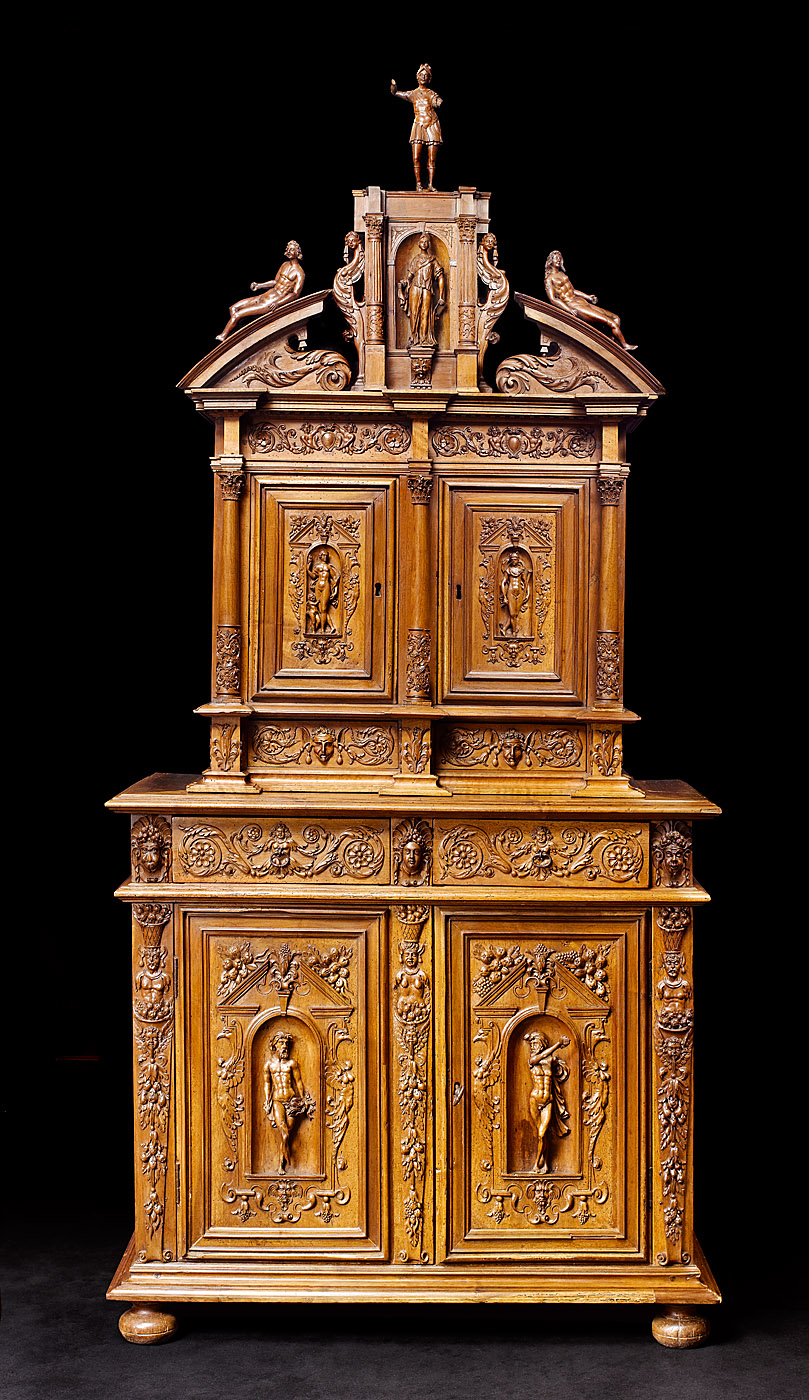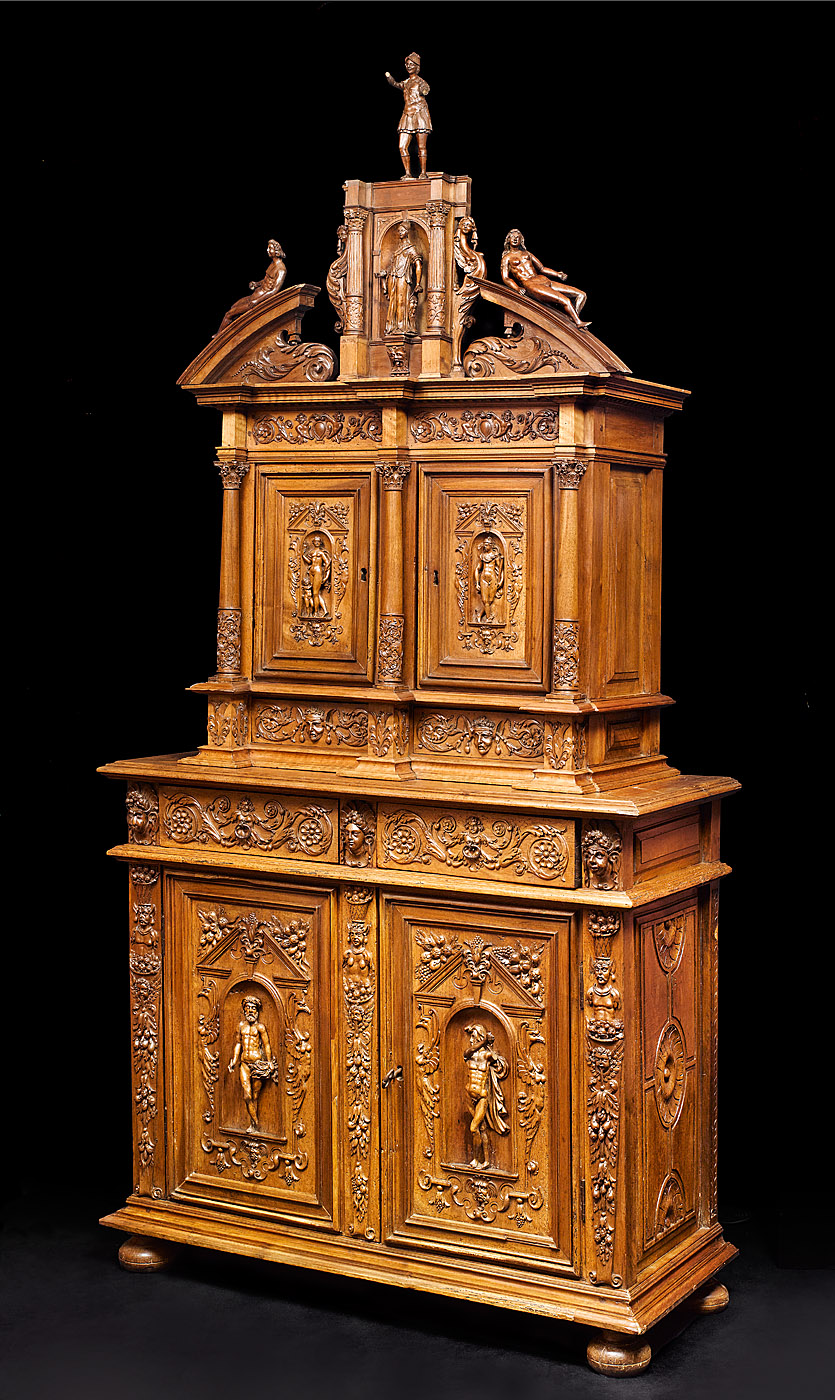Description
This cabinet is composed of two bodies, the upper one being recessed. The extraordinary proportions are enriched by a mythological and floral carved decor.
The Lower body stands on a moulded base with four bun-feet. It opens thanks to two door-leaves framed by male terms. Their sheaths bear angel heads, fruits and flowers. They have pointed ears and thick moustache and carry a fruits basket on their heads. The central term is a female one.
On each door-leaf a moulded frame is centered by a niche in which is carved almost in the round a human figure. The niche’s broken pediment is supported by harpies carvings.
The two characters rising proudly inside the niches come from mythologic tales.
Represented in their heroic nudity a drape is folded on their forehead and falls back showing the most beautiful effect. The personnage on the left can be recognized with no doubts as Zeus (Jupiter) holding in his left hand the thunderbolt. The right hand side personnage has lost the attributes that would have allowed an easy identification. Nevertheless he could be Pluto (Hades), ruler of the underworld and was probably carrying a fork. Furthermore the shadow at his feet let us think he was accompanied by Cerberus, the three-headed dog guarding the gates of the underworld. An engraving by Giovanni Jacopo Caraglio after Rosso Fiorentino depicts Pluto in a way that is very close to our sculpture.
The latteral sides of the cupboard are ornated by a rose linked with a ribbon to two semi-roses.
Above this part the belt bears three human-like masks. It opens with two drawers enriched by vegetal scrolls emerging from putti heads.
The upper body is divided into several registers and shows a strong recess. The lower part is composed of two carved panels depicting pointed-hears grining masks wearing earings and from which emerge vegetal scrolls. Behind those panels hide two drawers closed thanks to a secret mechanism. Indeed those drawers can be locked from the inside of the cupboard by placing a dowel at the right place. The lack of handle or lock prevent anyone from guessing drawers are hidden.
The main part of the upper body is divided by three corinthian columns with a plain shaft and finely carved scrolls on its base. The door-leaves present a similar composition compared to the lower door leaves.
Two other gods are depicted in the niches. On the left hand side Venus (Aphrodite) with Cupid (Eros) and on the right hand side Mercury (Hermes).
Venus is naked and carries in her right hand a flaming torch symbolizing love. We can recognize her son with his wings and his quiver.
Mercury, son and messenger of Jupiter is identified by his winged sandals and his petasus. In his left hand he holds a trumpet while in the other hand he carried the caduceus.
The upper body is topped by an entablature and an extraordinary pediment. The entablature is composed of an architrave divided in two panels. Each one shows a carved decor centered by a shield on a cut-out leather held by two child-like creatures with vegetal bodies.
The large broken circular pediment carries on the acroterions a female and a male figure. Inside the central part of the pediment two corinthian columns framed by chimeraes support an entablature. In this little niche is depicted Minerva (Athena). The goddess of wisdom wears the peplos and holds on the ground her shield with the gorgoneion, Medusa’s face.
On the top of the triomphal element is standing Mars, god of war with a helmet on his head and wearing his armour.
Historical Context
The second French Renaissance, starting around 1545, provoked a profound renewal in the furniture making.
The furniture structure with its harmonious proportions finds inspiration in the architecture. Antic orders are in vogue, thanks to architectural treaties such as Vitruve’s.
The ornamental vocabulary has also changed. Italian art’s influence shaped by humanism and antic discoveries leads to an evolution in decorative motifs. The presence of Italian artists -Il Rosso, Il Primaticcio, Niccolo dell’Abbate- on royal building sites allow a revitalisation of French art. Thanks to engraving and its diffusion, artists from all over the realm can discover and use this new vocabulary. Palm leaves, acanthus, flower garlands, grape fruits appear. This luxurious flora is accompanied by a fabulous fauna with harpies and chimeraes. The caryatid order knows a strong favor and artists love to use those figures on rich sheaths. Antic mythology is also very much in use being a pretext to sensual depictions, naked and muscular bodies.
Wood-carvers from the second half of the 16th century often find inspirations in those books of ornaments. The cupboard we present to you exhibits every characteristics of this second French Renaissance. One can only admire the beautiful unity of its decor, a legacy of Fontainebleau art. The gods and godesses in the niches are depicted in a refined and supple manner. It can be compared to Giovanni Jacopo Caraglio 1526 engravings after Rosso Fiorentino’s set of Divinités de la Fable. Represented inside niches these elegant divinities were perfectly adapted to a cupboard’s door leaves.
Furthermore this cabinet is exceptionnal by the quality of its wood and because of the mastery of its maker. The law-reliefs and in the round carving’s delicacy of execution, the details worthy of a goldsmith testifie of this wood-carver gifts.
This two bodies cupboard stands as a particularly precious exemple of the second French Renaissance during the late 16th century.
Bibliography
Jacqueline Boccador, Le mobilier français du Moyen-âge à la Renaissance, Ed. Monelle Hayot
Jacques Thirion, Le mobilier du Moyen-âge et de la Renaissance et France
James Hall, Dictionnaire des Mythes et des Symboles
https://metmuseum.org/art/collection/search/368128


